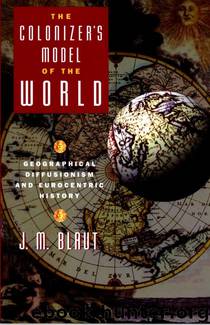The Colonizer's Model of the World by J. M. Blaut

Author:J. M. Blaut [Blaut, J. M.]
Language: eng
Format: epub
Publisher: The Guilford Press
Family
There is nothing new about the belief that the European family is in some fundamental sense more rational and more civilized than the family types found elsewhere. When the modernization doctrine became dominant, this belief seems to have faded into the background; there was now a near-consensus among social scientists that differences in family type should be strung along the continuum from “traditional” to “modern” or, as a variation, from “folk” to “urban.” Traditional families, it was argued, have tended to reflect strong kinship ties at a scale larger and wider than the nuclear family; they have tended to form large, extended-family households; and they have tended to be associated with high birthrates. In the absence of much evidence concerning the medieval European family and household, it was rather widely assumed that earlier European families had conformed to the traditional model, which was seen as the “preindustrial” family, contrasted with the modern, post-industrial-revolution nuclear family, forming a small household, with looser kin ties beyond the household, and with fewer children. This transformation was thought to be associated with what was called the “demographic transition,” the process of change from a “traditional” demographic pattern, with high birthrate and high deathrate, characteristic of preindustrial conditions, to a “modern,” postindustrial demographic pattern, with low birthrate and low deathrate.
In the modernization theory of the family, the non-European world of underdeveloped countries would go through essentially the same transformation as it modernized. Extended family households would be replaced by nuclear family households. This would instill modern prodevelopment attitudes: people would have fewer children (thus combating overpopulation), and they would tend, now, to think more individualistically and thus entrepreneurially.
All of this was a bundle of assumptions. There was no evidence of a causal link between birthrate and size of household (or strength of kin ties beyond the nuclear family); there was merely a correlation within rich, modern societies: both nuclear families and lower birthrates were characteristic of these societies. (One leading demographer pointed out that nuclear families might, in principle, be likely to have more children per couple than extended families.174) In addition, the idea that an adult breadwinner would be more entrepreneurial, more prone to accumulate capital, more competitive, and so on, if he (assumed to be male) was working only for his wife and children and not for a large family including his parents, cousins, and other relations, was a tenuous assumption. Large, tightly knit families had proven to be powerful accumulators, for instance, among many immigrant groups engaged in commerce. Why, indeed, should an adult want to work harder only for spouse and children, and not for parents, sisters, and so on? (One can in fact construct an argument to the effect that an extended family with multiple working adults has definite economic advantages in a developing economy.175) As the modernization doctrine itself developed, after about 1960, these ideas began to dissipate. It became clear that various forms of social organization can be equally modern, and that the root causes of change and nonchange do not lie in the family structure.
Download
This site does not store any files on its server. We only index and link to content provided by other sites. Please contact the content providers to delete copyright contents if any and email us, we'll remove relevant links or contents immediately.
| Historic | Information Systems |
| Regional |
Man-made Catastrophes and Risk Information Concealment by Dmitry Chernov & Didier Sornette(5921)
The Revenge of Geography: What the Map Tells Us About Coming Conflicts and the Battle Against Fate by Kaplan Robert D(4034)
Zero Waste Home by Bea Johnson(3777)
COSMOS by Carl Sagan(3553)
Good by S. Walden(3485)
In a Sunburned Country by Bill Bryson(3481)
The Fate of Rome: Climate, Disease, and the End of an Empire (The Princeton History of the Ancient World) by Kyle Harper(3003)
A Wilder Time by William E. Glassley(2818)
Camino Island by John Grisham(2762)
The Ogre by Doug Scott(2631)
Organic Mushroom Farming and Mycoremediation by Tradd Cotter(2626)
Human Dynamics Research in Smart and Connected Communities by Shih-Lung Shaw & Daniel Sui(2465)
Energy Myths and Realities by Vaclav Smil(2438)
The Traveler's Gift by Andy Andrews(2409)
9781803241661-PYTHON FOR ARCGIS PRO by Unknown(2321)
Inside the Middle East by Avi Melamed(2305)
Birds of New Guinea by Pratt Thane K.; Beehler Bruce M.; Anderton John C(2223)
A History of Warfare by John Keegan(2185)
Ultimate Navigation Manual by Lyle Brotherton(2129)
